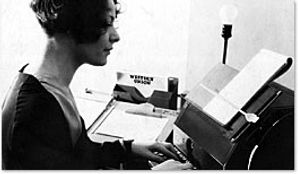Women in the 1920's

The 1920's had started out as a difficult time for women in Canada, who had very few rights compared to men. It began with many women either losing their jobs or getting paid less for working so that men who returned from the war could have them back. Instead of having unemployed men, it was better to have unemployed women because they weren't as strong as men in the eyes of employers. Besides, women had been used to having to stay home and care for their children four years ago, before the war had started. However, many women wanted a change so that they could work like men did.
So, in the 20's ladies in Canada decided that it was time for a change. Soon they were able to regain their jobs or get new ones that were considered "female professions". For example, many women worked as librarians now, a job that didn't require very much strength- after all, they were still considered the weaker sex. Another very popular field they might work in was clerical, because it wasn't as hard as a man's job- women wouldn't tire as quickly according to their employers. Still, even though there were some restrictions, the 20's were a time for women to work just as they had during the war and feel just as important as before.
Women
Men
Below is a chart comparing women's and men's rights in the 1920's:
Click Me!
-
Women in Quebec were unable to vote.
-
Until 1922, married women in Alberta were unable to have the same legal capacity as men.
-
Women were considered the weaker sex and therefore were either unemployed or did not have job with as high of a profit as men.
-
Women were finally able to obtain a divorce on the exact same grounds as a man would have.
-
Women were able to compete in the Olympics as of 1928.
-
The Equal Pay Legislation was not introduced until 1951, so until then women got paid significantly less than men.
-
First Nations men or men from other countries were unable to vote.
-
Considered the stronger sex and had great pickings for jobs.
-
Wounded men from the war remained unemployed however.
-
Men were the ones to decide whether or not women were considered "persons".
-
Men had always been able to complete in the Olympics.
-
Until 1951, men were paid much more than women for doing the same work for the same amount of hours.


As illustrated above, men in Canada had more rights and freedoms than women in the 1920's. Perhaps this was because they ruled the majority of the government. After all, it was men who were considered the stronger and more intelligent sex, so therefore it was them who got to make the descision as to what rights women were entitled to. As well, there were many more men in governmental roles than women. However this way of thinking was primitive and was therefore disregarded by many people later in the century. Eventually women did gain many rights, such as the right to vote which took many years to occur throughout all of Canada, but did eventually happen. Still- although we have many of the rights and freedoms men are entitled to nowadays- women are still not quite considered equal, although they should be. However, there is hope that there will be many more iconic women, such as Malala Yousafzai, who will prove worldwide that all women are equal to men and that women internationally deserve the same rights as men.